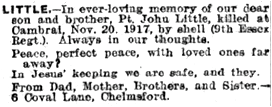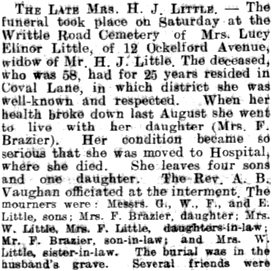John Little (usually known as ‘Jack’) was born and brought up in Chelmsford. He joined the army at 17, was wounded and brought home to recover before going to serve in Ireland and then once more in France. He was killed by a shell at the Battle of Cambrai in November 1917. His home was in Coval Lane.
Jack was born in Chelmsford in 1897, the son of Henry John ‘Jack’ and Lucy Elenor Little (nee Atkins). His father had been born c1861 in Mayland; his mother c1876 in Leicester, Leicestershire.
Jack’s seven siblings included Alfred Little (1898-1909), George Little (born 1900), William Little (born 1903), Frederick Little (born c1904), Ivy Edith Little (1905-1989) and Edward Little (born 1909). They were all Chelmsford-born, but by 1911 only five would still be alive.
The 1901 census listed Jack, his parents and two brothers at 24 Lower Anchor Street, Chelmsford (later renumbered as 28). His father was an ostler, in charge of the horses at the Lion and Lamb Inn in Duke Street, Chelmsford for Fred Young, and later employed by the Chelmsford Brewery Company.
The 1911 census found 14 year-old Jack living with his parents and five siblings at 6 Coval Lane in Chelmsford. Jack was a chemist’s errand boy; his father a cab driver.
Jack lived and enlisted at Chelmsford, serving as Private 40083 in the 9th (Service) Battalion of the Essex Regiment. His battalion was part of the 35th Brigade in the 12th (Eastern) Division, one of six Divisions which together formed the first part of ‘Kitchener’s Army’ from August 1914. The battalion was raised at Shornecliffe in Kent. The battalion had landed in France at the end of May/start of June 1915, entering the front line in July 1915 near Ploegsteert Wood, Belgium, close to the French border, a comparatively quiet sector.
In November 1917 Jack’s battalion participated in the Battle of Cambrai in France. The battle opened on 20th November 1917 when the British launched an offensive along a ten mile front west of Cambrai that marked the first large-scale, effective use tanks. A post-war history of Jack’s battalion reported:
“All was then ready for the advance, which started at 6.20 a.m. on November 20th, with the roar of British guns along the whole line. Ten minutes later the tanks commenced to amble at the leisurely rate of fifty yards per minute, followed by the infantry under protection of the barrage and numerous aeroplanes. The 35th Brigade had the 5th Royal Berkshires on the right and 9th Essex (La Terriere) on the left. Each Battalion was accompanied by a dozen tanks, but unfortunately nearly half of them broke down or stuck in a sunken lane leading from Gonnelieu to Banteux. The intermediate objective (the Black Line) was, however, quickly gained and then the 7th Suffolks, with a company of the 7th Norfolks, went through and took their alloted portion of the Hindenberg Line and thus completed the task of the 35th Brigade....The Division’s casualties were comparatively light, being no more than 144 killed, 864 wounded and 160 missing.....The 12th Division was occupied in consolidating the position during the next few days and improving the line by means of local attacks.”
Jack was amongst those who killed in action, by a shell on 20th November 1917. He was aged 20.
LITTLE, JOHN,
Private, 9th (Service) Battalion, Essex Regiment
On 30th November 1917 the Essex Weekly News reported:
“Pte. Jack Little, Essex regt., killed in action, was the son of Mr. and Mrs. Jack Little, of Coval-lane, Chelmsford. At the age of 17 he joined the Colours, went to France, was shot through an arm, and leg on Oct. 23 [sic], 1916, and lay in a shell hole for three days without food or water. Brought to England, he recovered from his wounds and from trench feet, went to Ireland, and afterwards to the Front again in June last. He was killed by a shell on Nov. 23, aged 20.”
News of his death appeared in the Essex County Chronicle of 7th December 1917:
“Pt. Jack Little, Essex Regt., killed in action by a shell on Nov. 23rd [sic], aged 20, was the son of Mr. and Mrs Jack Little, of Coval Lane, Chelmsford. He joined the Colours at the aged of 17. In October 1916 he was shot through the arm and leg and lay in a shell hole for three days without food or water, He recovered, went to Ireland, and to the Front again in June last.”
Jack is commemorated at Cambrai Memorial, Louverval, Nord in France, which commemorates more than 7,000 servicemen of the United Kingdom and South Africa who died in the Battle of Cambrai in November and December 1917 and whose graves are not known.
He is also commemorated by the Civic Centre Memorial, Chelmsford and by the Chelmsford Parish Great War Memorial in Chelmsford Cathedral. He was entitled to the British War Medal and Victory Medal.
The 1918 register of electors listed Jack’s parents at 6 Coval Lane, Chelmsford (now demolished).
His father died in 1933, aged 72. His mother died the following year, aged 58..
131116

